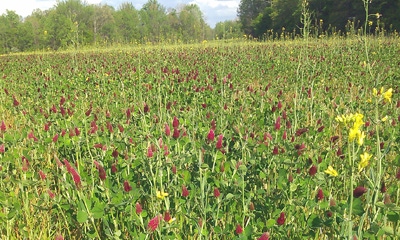
Roger Wenning, Greensburg, rolled the dice this spring. He had both crimson clover and grasses in his cover crop mix for 2016. He is one of the first people to try burning down the grass with a selective herbicide and allowing crimson clover to grow, perhaps for another week or two.
Here is our short interview with Wenning:
IPF: You have experimented with cover crops for several years. Why?
Wenning: I see a benefit to soil health. Cover crops do many things. They hold the soil. Some can also produce nitrogen for the crop.
IPF: You told us about a field with a three-way mix of annual ryegrass, crimson clover and rapeseed. Why did you include crimson clover?

LET CRIMSON GROW: Roger Wenning sprayed to knock down grass but let crimson clover grow longer.
Wenning: It was there to help produce nitrogen this spring. We had a good stand of all of our cover crops.
IPF: Why did you kill the annul ryegrass two weeks earlier than the crimson clover this spring?
Wenning: I didn’t want to chance it with going any longer with annual ryegrass. However, I also wanted to get the nitrogen-producing effects of crimson clover. For that to happen, the crimson clover needed to grow longer. Due to weather constraints, the cover probably got more than two weeks of extra growing time.
IPF: Does it bother you to plant with crimson clover getting rather tall?
Wenning: No, I have done similar things successfully.
About the Author(s)
You May Also Like




